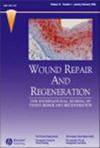3D skin bioprinting as promising therapeutic strategy for radiation‐associated skin injuries
IF 3.8
3区 医学
Q2 CELL BIOLOGY
引用次数: 0
Abstract
Both cutaneous radiation injury and radiation combined injury (RCI) could have serious skin traumas, which are collectively referred to as radiation‐associated skin injuries in this paper. These two types of skin injuries require special managements of wounds, and the therapeutic effects still need to be further improved. Cutaneous radiation injuries are common in both radiotherapy patients and victims of radioactive source accidents, which could lead to skin necrosis and ulcers in serious conditions. At present, there are still many challenges in management of cutaneous radiation injuries including early diagnosis, lesion assessment, and treatment prognosis. Radiation combined injuries are special and important issues in severe nuclear accidents, which often accompanied by serious skin traumas. Mass victims of RCI would be the focus of public health concern. Three‐dimensional (3D) bioprinting, as a versatile and favourable technique, offers effective approaches to fabricate biomimetic architectures with bioactivity, which provides potentials for resolve the challenges in treating radiation‐associated skin injuries. Combining with the cutting‐edge advances in 3D skin bioprinting, the authors analyse the damage characteristics of skin wounds in both cutaneous radiation injury and RCI and look forward to the potential value of 3D skin bioprinting for the treatments of radiation‐associated skin injuries.三维皮肤生物打印是治疗辐射相关皮肤损伤的有效方法
皮肤辐射损伤和辐射合并损伤(RCI)都可能造成严重的皮肤创伤,本文统称为辐射相关皮肤损伤。这两种皮肤损伤需要对伤口进行特殊处理,治疗效果仍有待进一步提高。皮肤辐射损伤常见于放疗患者和放射源事故受害者,严重时可导致皮肤坏死和溃疡。目前,皮肤放射损伤的治疗仍面临许多挑战,包括早期诊断、病变评估和治疗预后。辐射合并损伤是严重核事故中特殊而重要的问题,往往伴随着严重的皮肤创伤。辐射综合损伤的大规模受害者将成为公共卫生关注的焦点。三维(3D)生物打印作为一种多用途的有利技术,为制造具有生物活性的仿生结构提供了有效方法,为解决辐射相关皮肤损伤的治疗难题提供了可能性。结合三维皮肤生物打印技术的前沿进展,作者分析了皮肤辐射损伤和RCI中皮肤伤口的损伤特征,并展望了三维皮肤生物打印技术在治疗辐射相关皮肤损伤方面的潜在价值。
本文章由计算机程序翻译,如有差异,请以英文原文为准。
求助全文
约1分钟内获得全文
求助全文
来源期刊

Wound Repair and Regeneration
医学-皮肤病学
CiteScore
5.90
自引率
3.40%
发文量
71
审稿时长
6-12 weeks
期刊介绍:
Wound Repair and Regeneration provides extensive international coverage of cellular and molecular biology, connective tissue, and biological mediator studies in the field of tissue repair and regeneration and serves a diverse audience of surgeons, plastic surgeons, dermatologists, biochemists, cell biologists, and others.
Wound Repair and Regeneration is the official journal of The Wound Healing Society, The European Tissue Repair Society, The Japanese Society for Wound Healing, and The Australian Wound Management Association.
 求助内容:
求助内容: 应助结果提醒方式:
应助结果提醒方式:


